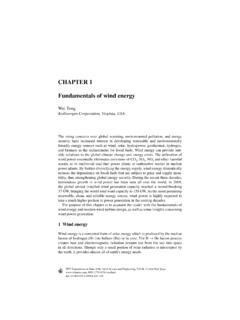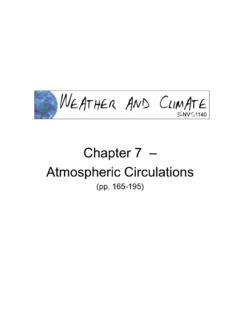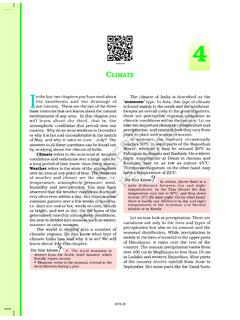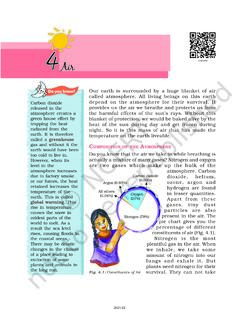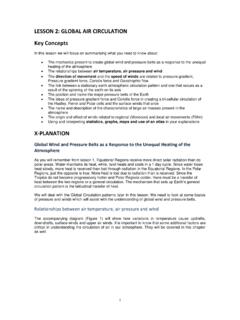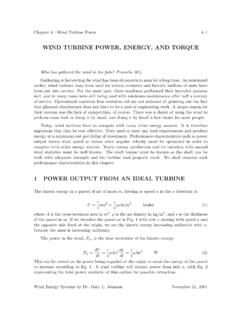Transcription of CHAPTER 5 OPEN-CHANNEL FLOW
1 CHAPTER 5 OPEN-CHANNEL FLOW 1. INTRODUCTION 1 OPEN-CHANNEL flows are those that are not entirely included within rigid boundaries; a part of the flow is in contract with nothing at all, just empty space (Figure 5-1). The surface of the flow thus formed is called a free surface, because that flow boundary is freely deformable, in contrast to the solid boundaries. The boundary conditions at the free surface of an OPEN-CHANNEL flow are always that both the pressure and the shear stress are zero everywhere. But a flow can have a free surface but not be an OPEN-CHANNEL flow.
2 Closed-conduit flows that consist of two immiscible fluid phases of differing density in contact with each other along some bounding surface are not OPEN-CHANNEL flows , because they are nowhere in contact with open space, but they do have a freely deformable boundary within them. Such flows are free-surface flows but not OPEN-CHANNEL flows (Figure 5-2), although they are usually called stratified flows , because the density difference between the two fluids gives rise to gravitational effects in the flow. On the other hand, OPEN-CHANNEL flows are by their definition also free-surface flows .
3 Figure 5-1. An OPEN-CHANNEL flow. 2 In a narrow technical sense, flows of liquid at the Earth s surface, like ocean-surface currents or rivers, are not OPEN-CHANNEL flows , because they are in contact with another fluid the atmosphere at a free surface within a two-phase 157fluid medium. But the contrast in density between water and air is so great that in studying Earth-surface liquid flows we usually ignore the presence of the overlying atmosphere. Figure 5-2.
4 A free-surface flow that is not an OPEN-CHANNEL flow. 3 All of the principles and techniques for dealing with velocity structure and boundary resistance that were developed for closed-conduit flows in earlier chapters hold as well for OPEN-CHANNEL flows . In fact, much of the material in CHAPTER 4, on flow resistance and velocity structure, is about OPEN-CHANNEL flows . But OPEN-CHANNEL flows involve an important added element of complexity beyond what we have covered on laminar and turbulent flows in closed conduits: the presence of the free surface means that the geometry of the flow can change in the flow direction not just by being constrained to do so by virtue of the geometry of the boundaries but also by the behavior of the flow itself.
5 This means that the acceleration of gravity can no longer be ignored by the expedient of subtracting out the hydrostatic pressure, as with closed-conduit flows , because the force of gravity helps to shape the free surface. So gravity must therefore be included as an additional independent variable in dealing with free-surface flows . You have already seen an example of this back in CHAPTER 1, when a sphere was towed underwater but near the free surface. 4 Also, under the right conditions gravity waves can be generated on the free surface, whether or not the fluid is flowing.
6 When the deformable free surface is momentarily deformed in some small area by a deforming force of some sort by the force of the wind, or by your agitating the water with your hand the force of gravity acts to try to restore the free surface to its original planar condition. Provided that the viscosity of the liquid is not too high (have you ever tried to make waves in a vat of molasses?) this attempt at restoration of a deformed free surface leads to the propagation of gravity waves away from the region of surface disturbance.
7 5 This CHAPTER is a selective presentation of some important topics in free-surface flow. I will defer consideration of the generation and propagation of 158gravity waves on the free surface of a standing or flowing body of liquid until CHAPTER 6, on oscillatory flow. TWO PRACTICAL PROBLEMS 6 One of the interesting things about OPEN-CHANNEL flow is the effect of gravity on the shape of the free surface relative to the solid boundary. Babbling brooks and white-water rivers clearly have complex free-surface geometries governed by bed relief, expansions and contractions of the channel , and, less obviously, upstream and downstream conditions.
8 But all OPEN-CHANNEL flow, even broad, majestic rivers like the Mississippi, or flows in laboratory channels we try to keep as nearly uniform as possible, are subject to such effects of gravity. To make this effect concrete, I will pose two questions at this point for you to think about. Both are of great practical importance to engineers dealing with OPEN-CHANNEL flows . 7 Your intuition might have some trouble with the first question. Suppose that you set up a nice OPEN-CHANNEL flow, in a wide rectangular channel , just for the sake of definiteness, with a planar bottom, which may or may not be sloping.
9 Then, at a particular position down along the channel you introduce a smooth and gentle step in the channel bottom, either upward or downward (Figure 5-3). The question is: does the water surface rise or fall over the step, relative to its upstream level? Figure 5-3. A positive step and a negative step in a channel bottom. 8 You will probably feel more comfortable with the second question. A river with a constant bottom slope is dammed at a certain point, so that the river has to merge somehow into a deep reservoir formed in the river valley (Figure 1595-4).
10 You can assume that far upstream in the channel the flow is very nearly uniform. That sloping water surface upstream has to pass continuously into the horizontal water surface of the reservoir, where the water velocity is negligible. What would the water-surface profile look like along a streamwise vertical cross section through the channel and the reservoir? Would it change very gradually, all the while sloping monotonically down toward the reservoir? Or would it continue unchanged all the way to the reservoir level, to meet the water surface in the reservoir by an abrupt change in water-surface slope?










